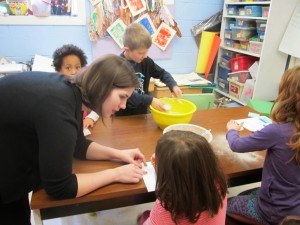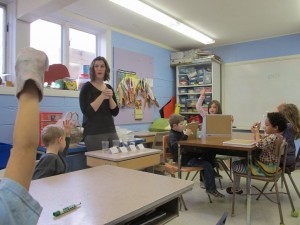Our student teacher, Taylor, taught students in grades K-1 a math class on weight and volume. Students began with weight. During the first class, students were given two objects and holding one in each hand, had to tell the class which one felt heavier or lighter. As the class progressed, students began exploring weight using arm balances. Students were given several different objects and were directed to put specific objects on the balance to determine which one is heavier. Students quickly realized that one side of the balance goes down when it has a heavier object in the pan. Students were able to continue their exploration of weight in weight centers during contract time. They were given a deck of cards and had to determine how many of a certain material (chips, weights, pebbles, cubes, blocks) would weigh the same as the deck of cards and balance the scale.
Then we moved on to volume. Volume was a bit trickier but students quickly learned. The first day we learned about volume, Taylor asked students what they thought volume was and students gave responses such as loud or quiet, the volume on a TV or radio, etc. Then we did fun hands on activity where students worked with a partner to see how many spoonfuls of sand would fill a cup. The next class, Taylor asked students what they thought volume was now that they did the sand activity and students gave various responses such as volume is how much sand fills a cup or how much fits in the cup. In the next volume class, students were shown 4 cups, all the same size, but with different amounts of water in them. Taylor asked questions such as which cup has the most amount of water? Which cup has the least amount of water? Students wrote their responses on a white board. Then students were shown 4 very different sized containers, each with a cup of water and asked students the same questions. Students gave various responses. At the end of the lesson, Taylor revealed that all 4 different sized containers had the same amount of water. Students were shocked! The students’ definitions for volume grew. The final lesson on volume, students watched a youtube video of a young man reading the story “Mr. Archimedes Bath” by Pamela Allen. Archimedes was a mathematician who discovered that when he takes a bath, the water level rises and that must mean he has volume. We then performed Archimedes experiment using a doll and a rectangular container as the “bath.” Students watched as the water level rose when the doll was placed in the bath.
Students were very intrigued about what they learned in our weight and volume class and certainly were engaged in all of the fun, hands on activities!

